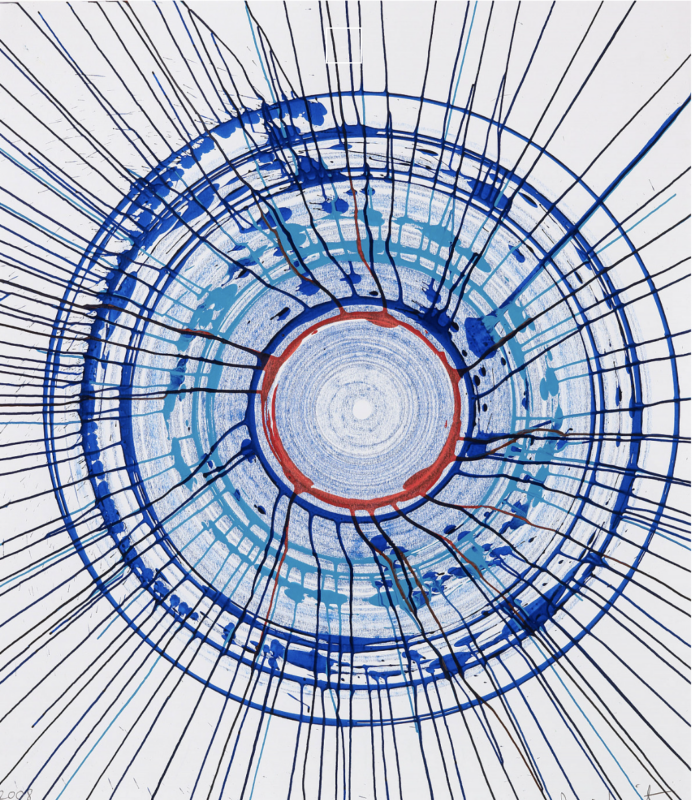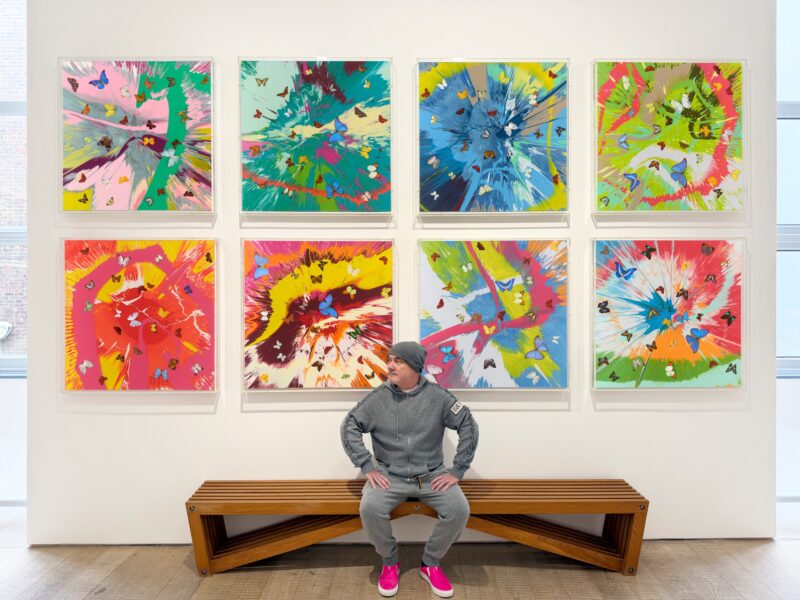View this post on Instagram
The Empresses is a series of five prints depicting carefully composed images of butterflies by Damien Hirst and published by HENI Editions. The prints are available to purchase on HENI until 5pm UTC on Friday 4th February 2022. The final number of editions produced will be limited by demand during this time period. The edition is priced at $3,500.
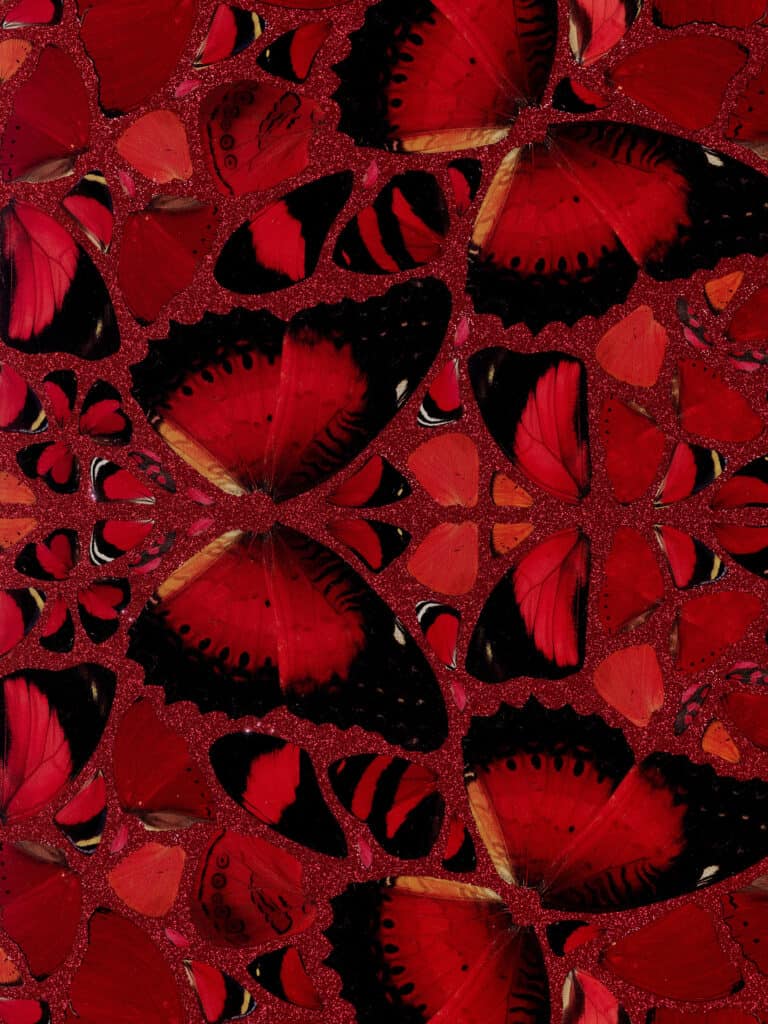
HENI is offering the ability to either purchase the physical prints directly, or to delay receipt of the print for up to 3 years by purchasing a “HENI Editions NFT Deed”. This new category of HENI NFT allows collectors to redeem their NFT for the physical artwork at a later date, and also to pass on their entitlement to the print through trading the NFT, thus giving a maximum of flexibility to collectors. The striking Empresses prints are constructed of beautiful images of red butterfly wings, which are intricately arranged with a filigree of red glitter to produce visually intoxicating kaleidoscope-like effects. The prints are named after five exceptionally influential female rulers: Wu Zetian, Nur Jahan, Theodora, Suiko and Taytu Betul. Their characters and stories are enhanced by the dominant red tone of the series, which deals with themes such as life, war, power, anger, love, joy and luck.
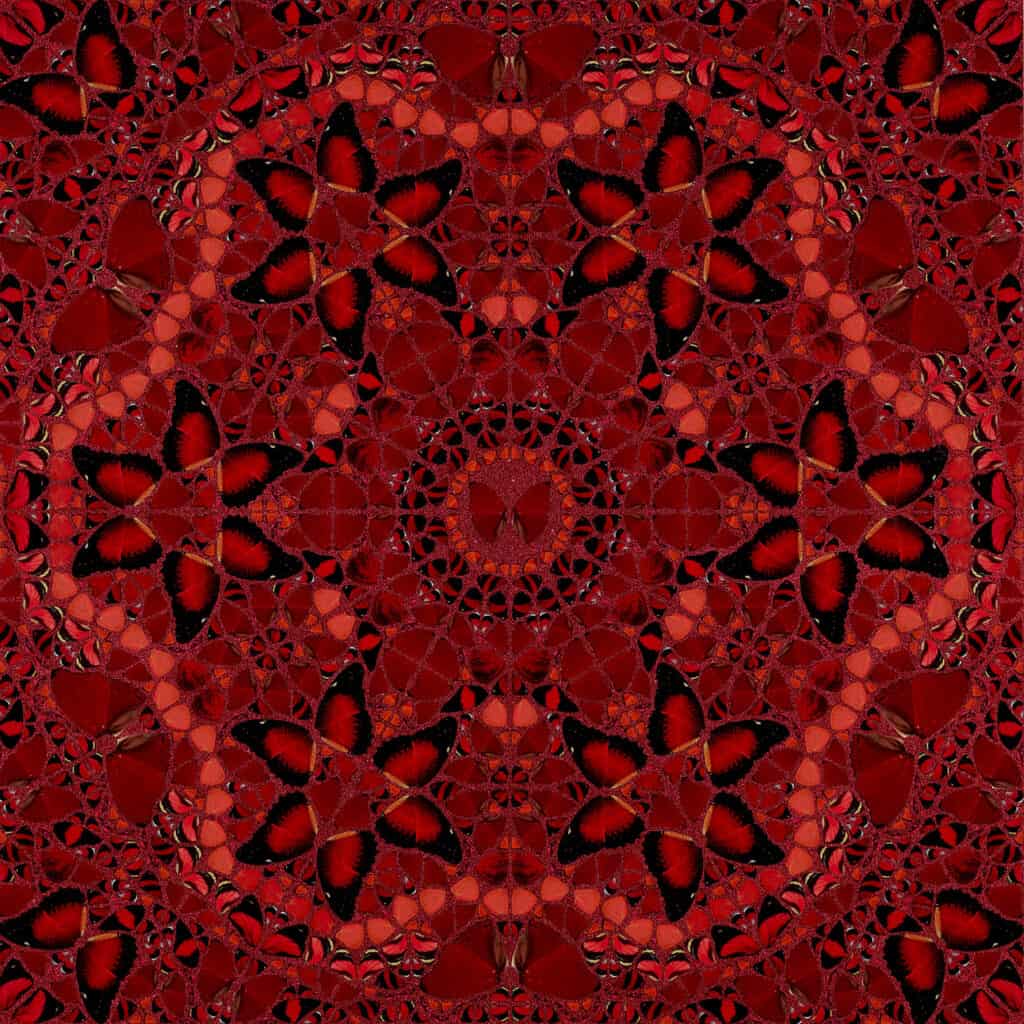
For this launch, as well as US Dollars and fiat currency, HENI will accept the following cryptocurrencies as payment for the prints: Bitcoin (BTC), Ether (ETH) and USDC.
The Editions
Since the beginning of his career, Hirst has interacted with the butterfly, one of his best-known motifs. Inspired by a chance encounter in his studio and the intricate patterns found on Victorian tea trays, in The Empresses Hirst develops on the complex compositions he invented in his Kaleidoscope Paintings and Mandalas series. The Empresses prints are symmetrical, asymmetrical, and spiral patterns of meticulously organised butterflies that nonetheless exude hope and life – the butterflies feel as if they are taking flight. This effect is in part aided by the material, laminated Giclée print on aluminium composite, screen printed with glitter, which allows the butterfly wings to be presented in such detail that they appear lifelike. The images of wings inspire awe and are framed by glitter, a fantastically tactile material previously used by Hirst in his paintings. Glitter is loved for its playfulness and joy – a sentiment echoed in the play-on-words of the series title itself, which alludes to both female rulers and the Empress Butterfly. Hirst has consistently used butterflies for their associations to freedom, religion, life and death. The Empresses illuminates and sheds light on these themes. Through this new series, these themes become intertwined with glory, female power and the development of nations, visible through the entrancing twists and turns of these five dazzling and vital visual celebrations.
The Empresses
H10-1 Wu Zetian

Rife with symbolism and with a hexagonal composition at its centre, Wu Zetian is named for the successful Chinese empress. In 655 CE Wu Zetian (624-705 CE) married Emperor Gaozong and gradually began to involve herself in political affairs, much to the dismay of many statesmen. Using her extraordinary intelligence, Wu Zetian created stability in the empire and consolidated the Tang Dynasty at a time when it appeared to be crumbling. At the centre of Wu Zetian is a single pair of butterfly wings, which is surrounded by a concentric circle of paired wings. This arrangement blossoms into a dynamic and symmetrical hexagonal formation which has an arrangement of three pairs of wings within each point. This reliance on the number six to establish the composition recalls its reappearance across Chinese idioms to denote good will, installing six as a lucky number. The number gains additional significance as it relates to the hexagon, which in China evokes the six directions (North, South, East, West, Heaven and Earth) and therefore represents completeness, harmony and balance. These associations also recall the story of Wu Zetian whose intelligence, courage and decisiveness brought stability to her empire. Beautifully outlined with brilliant red wings, the four corners of the picture plane are filled with further arrangements of single or paired wings. The clever transitions between compositional structures in Wu Zetian lends a captivating complexity to the work that leaves it apparently ever-changing, imparting into the work a sense of movement. Effectively, the composition infuses the print with the sensation that the butterflies are indeed alive and are billowing out into the space of the viewer.
H10-2 Nur Jahan
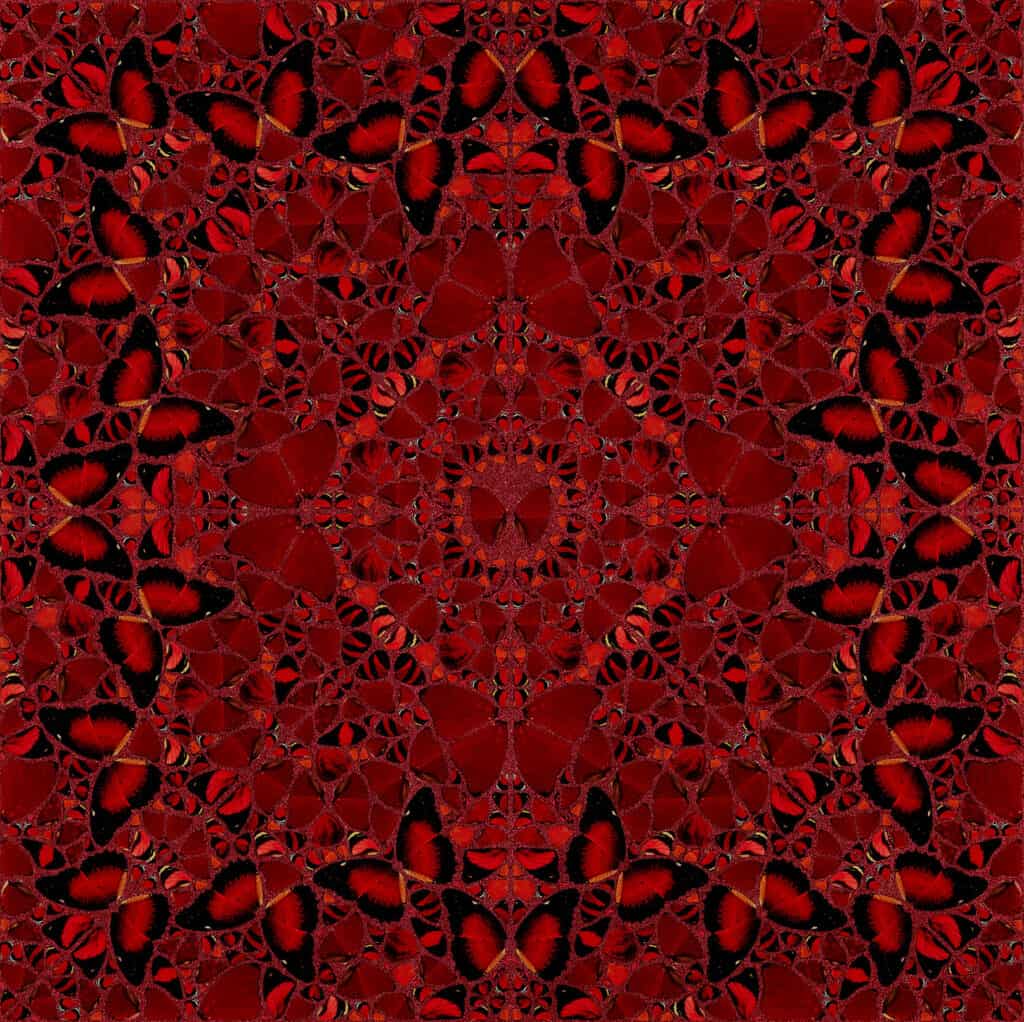
Nur Jahan, defined by complex mosaic-like arrangements and a structural composition, is named after the multi-skilled de-facto empress of the Mughal Empire. In 1611 Nur Jahan (1577-1645) became Emperor Jahangir’s 20th wife, but not officially his empress. Nonetheless, she exerted her influence on the empire, minting coins in her name and issuing royal decrees. A great diplomat, a skilled hunter and a successful advisor, Nur Jahan was also a talented architect – her designs for her parent’s tomb in Agra are believed to have inspired the Taj Mahal. In Nur Jahn, single or paired wings in various sizes and striking hues of red and black are arranged into perfectly symmetrical patterns. The wings emanate out from the centre vertically, horizontally and diagonally to create entrancing kaleidoscope-like patterns. The focal square composition appears to enshrine the central pair of wings, with the surrounding arrangements of wings seemingly receding and therefore directing the eye to its centre. This intricate, tectonic organisation recalls the architectural efforts of Nur Jahan and the glorious mosaic tiles that adorn the Agra tomb. The arrangement of Nur Jahan is in a constant state of transformation – new passages of patterns of extraordinary wings are revealed the longer it is studied and the more the viewer changes their position before it. Such is true of the large black and red pairs of wings that encircle the composition at its outer edge, alternately arranged to create an uneven frame. In doing so, Hirst infuses into this orderly composition a sense of vitality, that these butterflies are captured in a moment of variously directional flight.
H10-3 Theodora
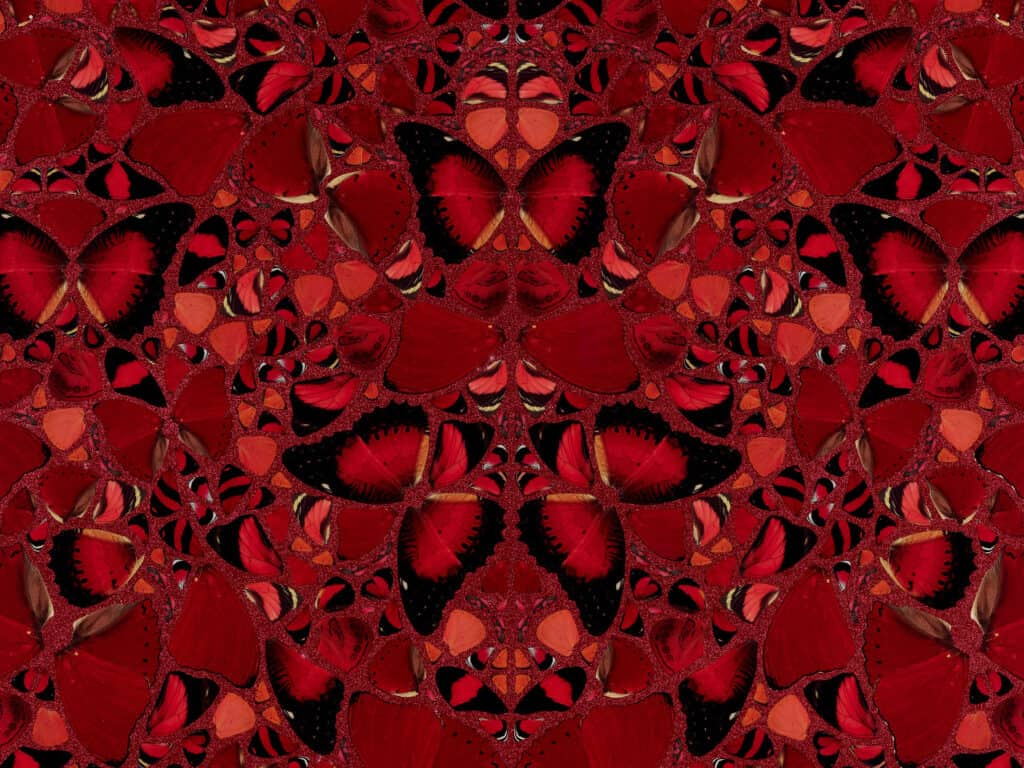
Extraordinarily complex and dynamic, Theodora is named for the great Byzantine empress who used her intelligence and savvy to create lasting change in the empire. Born into the lowest class of Byzantine society, Theodora (497-548 CE) rose to power in 527 CE following her marriage to Emperor Justinian. She left a significant impact on the region, namely through implementing new religious and social policies. Indeed, Theodora’s power over the empire left many to wonder if it was her and not Justinian that ruled. In Theodora various hues of red and black butterfly wings assemble into an intriguing asymmetrical pattern, the only of its kind from the series. The composition is defined by lines of glittering red, noticeable only at proximity, which symmetrically sections the print horizontally into thirds and vertically in half, as well as establishes a circle in the upper half of the print. The lower horizontal band, the circle and the vertical line are the most prominent, creating a formation reminiscent of the female gender symbol. Such recalls some of Theodora’s landmark policies that benefited women, including prohibiting the trafficking of girls and amending divorce laws to give women more rights. With the wings arranged in pairs or singularly across the work, Theodora stands out for its degree of organised chaos. The result of the carefully composed asymmetrical composition is the visual sensation that these wings are not lifeless specimens arranged for the viewer’s aesthetic pleasure but insects vibrating with life, captured zooming across (and perceivably beyond) the picture plane.
H10-4 Suiko

Suiko, a composition which evokes life in many ways, is titled after the first recorded empress of Japan. Though legend says that several females had ruled before Suiko (554-628 CE), her rise to power after her brother Sushun was murdered in 592 CE marked a break with tradition of installing male rulers. Suiko is remembered for the Chinese and Korean influences she brought to the country, including the implementation of the Chinese calendar, the arrival of Chinese and Korean craftsmen, and, perhaps most notably, the establishment of Buddhism. In Suiko, variously sized paired wings emanate from the work’s centre, producing a symmetrical concentric circle, a compositional arrangement that recalls Buddhist symbolism and the life cycle. This circular pattern is strikingly defined by glittering lines of red that diagonally cross the composition from the centre to meet each corner. With the wings set against a red background, the lines shoot through the pairs of disembodied wings where the bodies once existed. As is true of each work from the series, Suiko appears in a constant state of transformation, the butterflies moving and evolving the longer one stands before the work. While the intricacies can be truly appreciated up close to the print, from afar the composition takes on a new life. From this vantage point, Suiko reveals itself to have a ballooning arrangement of wings, which are organised around the central pattern of concentric circles and complemented by external arrangements of further wings. This arrangement is akin to a biological or molecular structure, evocative of the organisms that it depicts.
H10-5 Taytu Betul

A composition that is infused with an exhilarating sense of speed and movement, Taytu Betul is named after the fierce empress of Ethiopia. Upon her marriage to Emperor Menelik, in 1889 Taytu Betul (c. 1851-1918) became empress of Ethiopia. She was anything but a passive ruler, unequivocally resistant to imperialism and staunchly opposed to any negotiations that would result in a loss of Ethiopian territory. During her reign, Taytu Betul also founded Addis Ababa, which remains Ethiopia’s capital city today. Taytu Betul immediately draws the eye to the red and black pairs of wings that form the basis of the composition: the spiral. It begins at the centre of the work and moves outward, apparently past the picture plane. The momentum that develops as this composition progresses echoes the passion and physical dedication of Taytu Betul who was at the head of her army as they went to war to defend their borders. These wings are complemented by additional arrangements of variously sized, coloured and patterned wings, which form a sort of secondary backdrop to the central action of the work. Taytu Betul stands out from the series for its vigorous attempt to capture the butterflies in their true living form. With the composition resembling an aerial view, the print allows viewers to look downward as the momentum of this pack of butterflies is captured in the spiral and dynamic development of the composition.
